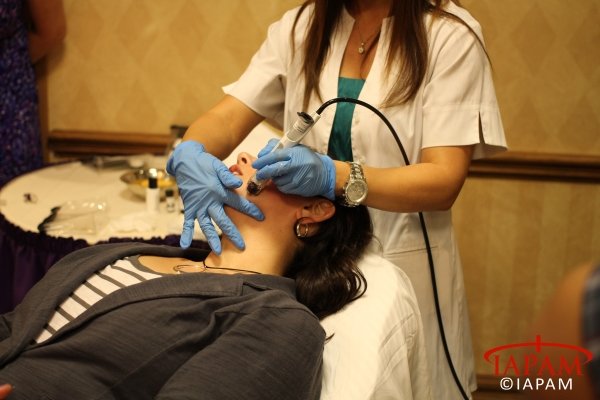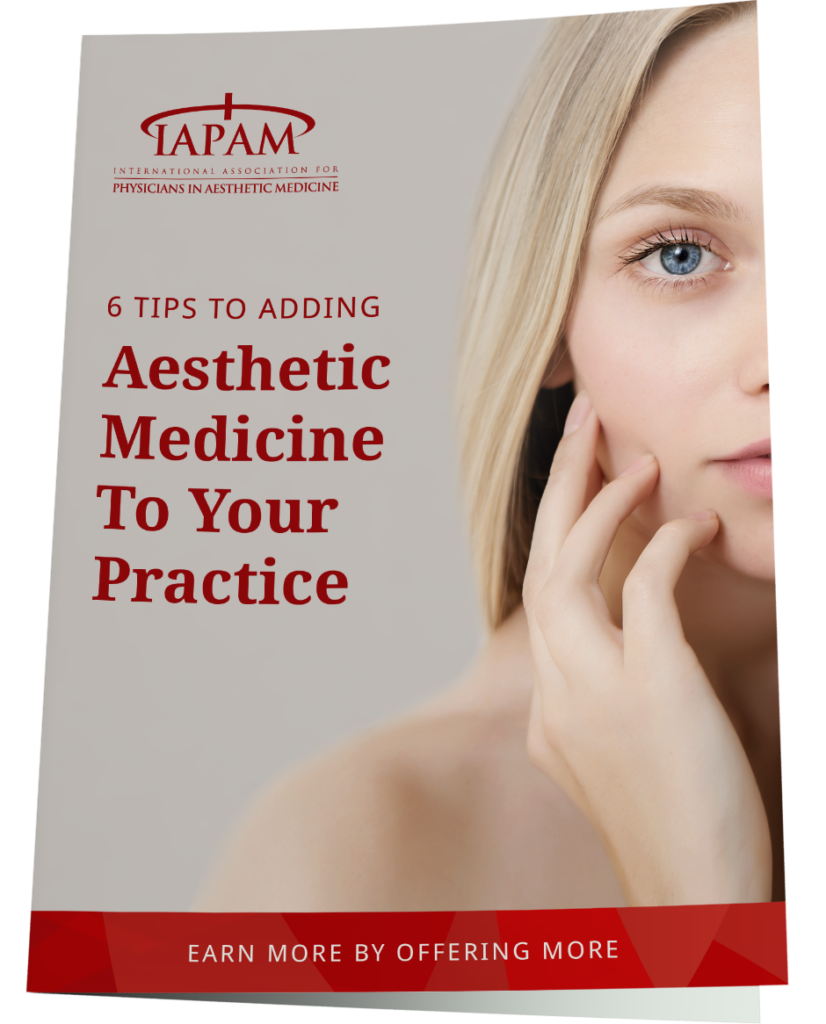Start and Grow a Profitable Botox®, Aesthetic Medicine or Medical Weight Management Practice
Menu

Menu

The IAPAM’s Aesthetic Medicine Symposium represents the most comprehensive minimally invasive modality training for physicians new to the aesthetic medicine field and want to grow their skills and their practice.
The IAPAM’s multi-day Aesthetic Medicine Symposium program focuses on the top 5 minimally-invasive treatments: botox, dermal fillers, medical microdermabrasion, medical grade chemical peels and laser and light procedures.

The use of exfoliating agents to peel the epidermis and superficial dermis date back to ancient Egypt. Sour milk baths were used to soothe the skin. Salt and brimstone were used to exfoliate and produce a more elegant appearance.
Today, deeper dermal injury is used to improve deformities due to photoaging and acne.
Chemabrasion and mechanical abrasion (dermabrasion) are used to resurface skin to achieve a more youthful appearance (Source: Photoaging, Rigel, Weiss and Lim, 2004).
The IAPAM focuses on training physicians and their medical staff in the best practices for two of the most popular skin rejuvenation procedures: medical-grade chemical peels and medical microdermabrasion.
For a comprehensive overview of the other core skin resurfacing treatment, see the IAPAM’s newly updated lasers and light therapies page.
Learn to Start a Profitable Aesthetics Practice in Just 4-Days!
May 31-June 3 (only 4 spots left!)
September 6-9
October 18-21
in sunny Scottsdale, AZ
Learn the clinical and business skills you need to transform your work/life balance with a profitable aesthetics practice in just
4-days!
Dates: May 31-June 3 (only 4 spots left!), September 6-9 and October 18-21
Scottsdale, AZ
*Members preferred price for 4-day accelerated program. Membership is only $295/yr and can be added during registration.
Since its introduction in the US in 1996, microdermabrasion offers a simple, relatively inexpensive treatment for photoaging, with rapid recovery time.
It is one of the most popular procedures in the US (ASPAS reported 522,693 microdermabrasion procedures in 2020).
It requires no anesthesia, and can be used on all Fitzpatrick skin types, and has minimal risk for dyschromia, infection or scarring.
Source: Photoaging, Rigel, Weiss and Lim, 2004.
Medical microdermabrasion is a resurfacing procedure with an abrasive instrument that mechanically sands the skin to remove some of the top skin layer (epidermis) and stimulate new skin growth.
By removing the outer skin layers and smoothing the treated skin the physician can achieve a rejuvenated appearance.
Using micro-particles, or a diamond-tipped wand, the plastic surgeon uses a device, like a fine sandblaster, to spray tiny crystals across the face, mixing gentle abrasion with suction to remove the dead, outer layer of skin.
As with other skin rejuvenation techniques, more than one treatment may be needed to reduce or remove fine wrinkles and unwanted pigmentation.
This technique is used to treat substantial scarring, discoloration, and sun damage, as well as:
Source: https://www.aad.org/public/publications/pamphlets/cosmetic_facial.html
According to the American Academy of Dermatology (AAD), medical microdermabrasion treatments are often needed and should be spaced two to three weeks apart.
Get 6 tips on adding aesthetics to your practice!
>> Request Your Free Guide
There are virtually no known side effects associated with microdermabrasion. The AAD advises that microdermabrasion does not require an anesthetic and involves little or no recovery time or downtime.
Patients can expect to pay more for medical microdermabrasion in major cities and in dermatologists’ offices. Average prices range from $125 to $180 in major urban centre and $65-125 elsewhere.
Equipment costs for adding medical microderm typically costs around $200-500/month.
Source: https://www.ehow.com/facts_5760543_cost-medical-microdermabrasion_.html
DermaFrac™ by Genesis Biosystems is an advanced skin rejuvenation technology combining micro-needling with simultaneous infusion. This modular system provides the option to add microdermabrasion and/or LED for an efficient, comprehensive treatment:
A more invasive form of skin resurfacing is dermabrasion (and dermaplanning).
Dermabrasion and dermaplaning help to “refinish” the skin’s top layers through a method of controlled surgical scraping. The treatments soften the sharp edges of surface irregularities, giving the skin a smoother appearance.
Dermabrasion is most often used to improve the look of facial skin left scarred by accidents or previous surgery, or to smooth out fine facial wrinkles, such as those around the mouth.
It’s also sometimes used to remove the pre-cancerous growths called keratoses. Dermaplaning is commonly used to treat deep acne scars.
Both dermabrasion and dermaplaning can be performed on small areas of skin or on the entire face. They can be used alone, or in conjunction with other procedures such as facelift, scar removal or revision, or chemical peel.
Source: www.plasticsurgery.org
The precise formula used may be adjusted to meet each patient’s needs. Peeling agents are classified as follows:
Adding aesthetics to your practice doesn't have to be hard. We've put together 6 tips to help show you how.
>> Request Your Free Guide
Alpha hydroxy acids are a group of water-soluble carboxylic acids. They work to release the desmosomes that hold skin cells together. This action allows for easier exfoliation and increased cell turnover.
AHA are also thought to stimulate fibroblasts to produce collagen and elastin to strengthen the matrix and firm the skin.
AHA, include glycolic acid, malic acid, tartaric acid, mandelic acid, lactic acid, or citric acid.
These types of peels can provide smoother, brighter-looking skin for people who can’t spare the time to recover from a phenol or deeper TCA peel.
AHA peels may be used to treat fine lines and wrinkles, areas of dryness, uneven pigmentation and acne.
Various concentrations of an AHA may be applied according to the skin condition being treated.
TCA is a very safe peeling agent that has been used for over 50 years. It does not absorb into the bloodstream. This acid is typically used at higher percentages by physicians for traditional chemical resurfacing procedure.
When used as a single acid at high percentages, it is best for textural concerns such as scarring and moderate to deeper wrinkling because of its action as a cauterant (breaking down living tissue).
It is typically more aggressive when used as a single acid, but can be safely applied as a superficial peel, even on higher Fitzpatrick and sensitive skin, when used in a blended formulation.
Phenol is the strongest of the chemical solutions. It is used mainly to treat patients with coarse facial wrinkles, damaged skin caused by sun exposure, or pre-cancerous growths.
Since phenol sometimes lightens the treated areas, your skin color may be a determining factor as to whether or not this is an appropriate treatment for you.
Phenol is primarily used on the face; scarring may result if it’s applied to the neck or other body areas.
With a phenol peel, the new skin frequently loses its ability to make pigment (that is, tan).
This means that not only will the skin be lighter in color, but protection from the sun will always be necessary.
Phenol may pose a special risk for patients with a history of heart disease.
It’s important that you make your surgeon aware of any heart problems when your medical history is taken.
It is also possible that phenol will cause some undesired cosmetic results, such as uneven pigment changes.
Certain modified phenol peels are gentler and may be preferred in some circumstances.
Jessner’s peel solution, formerly known as the Coombe’s formula, was pioneered by Dr. Max Jessner, a German-American dermatologist.
Dr. Jessner combined 14% salicylic acid, lactic acid and resorcinol in an ethanol base.
It is thought to break intracellular bridges between keratinocytes. It is very difficult to “overpeel” the skin due to the mild percentages associated with the acid combination.
The Jessner’s Peel is ideal for dull, slightly wrinkled, sensitive and dark skins and treatment for chronological aging and/or acne and acne scarring.
Do you want to know how to add non-invasive aesthetic treatments to your practice?
>> Request Your Free Guide
The Modified and Enhanced Jessner Solution was coined 20 years ago by PCA SKIN’s founder Margaret Ancira.
The original modified Jessner solution is enhanced with additional citric acid, kojic acid and hydroquinone for increased benefits.
Retinoic acid is derived from retinoids; which is denatured vitamin A. It is chemically similar to Retin-A.
Retinoids, which are vitamin A derivatives, have many benefits for the skin. They are ingredients that have many normalizing benefits.
They work to increase cell turnover and, at high percentages, act to increase post-treatment exfoliation.
This is particularly important for lifting pigmentation, reducing impaction in acne patients and when treating aging skin that has a naturally slowed cell turnover cycle.
Additionally, retinoids act as melanogenesis inhibitors by preventing the production and distribution of pigment.
Retinoic acid can be irritating to some skin types, although it may be necessary in more severe skin conditions.
Retinol is a gentler vitamin A derivative that is effective, yet non-irritating. Retinol is converted to retinoic acid in the skin.
Blended peels are unique in that they typically do not require neutralization. They are not timed and removed from the skin.
Instead, they are self-neutralizing and are left on the skin, with the exception of the masks, which are removed with moist cotton.
Unlike straight acid alpha hydroxy acid peels that can potentially collect in the upper portions of the skin and cause surface irritation or burns, blended peels can be formulated to be naturally neutralized by constituents of the skin and its water content.
The strength and depth of the treatment is controlled by the professional based on the number of layers applied during treatment.
After peel application, nutritive topicals and calming moisturizers with SPF are recommended and the patient leaves with a glowing, healthy complexion.
This makes the experience much more relaxed and pleasant for both the clinician and patient.
Scottsdale, Arizona

How to navigate adding aesthetic procedures to a new or existing practice.
Learn popular techniques, marketing, regulatory & insurance considerations and more!
Yours for $9.99 $0 when you subscribe to get our emails. Unsubscribe anytime.